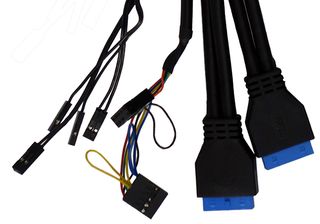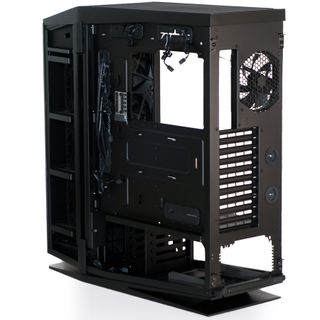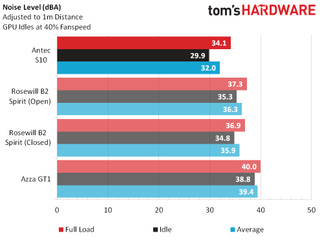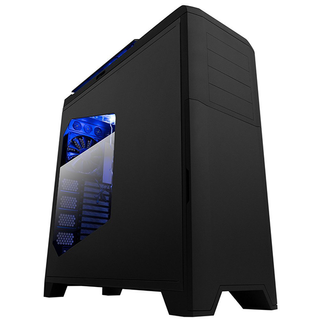Antec S10 10-Slot EATX Premium Case Review
Antec goes beyond its normal budget-to-professional range in its solid-aluminum paneled S10, but does the performance of this premium-material case help to justify its premium price?
Why you can trust Tom's Hardware
The Build, Test Results And Conclusion
The Build
The S10's installation kit surprised us with four SATA cables, in addition to the cleaning cloth, three-year warranty description, cable ties, screws, and motherboard standoffs.

Cables include two USB 3.0 dual-port plugs, HD Audio with the messy AC-97 adapter lead, a power LED that's split to allow installation on both standard (2-pin) and Asus (3-pin) spacing, HDD activity LED, and power button plug.
Also included but already installed on the back of the S10's motherboard tray is Antec's ten-fan power adapter.

Most builders prefer to install cables behind the motherboard tray, where they're not easily seen. The motherboard-section floor extends past the motherboard tray to the right side panel, and a groove at the front of this extension is barely large enough for the cables of our single-graphics-card test configuration. Any additional cables would need to run up the slot in the motherboard compartment floor.

Even an 11.75" graphics card can't consume the cavernous depths of Antec's S10 motherboard compartment, and leaves enough space for a 1.75"-thick radiator. A shorter card would have allowed stacking of a radiator between two layers of fans.

Unfortunately, while everything went into the S10 cleanly, the mere brushing of cables against the right side panel prevented it from holding closed. That's because the case uses a weak magnetic strip, rather than strong magnets or latches, to stop its doors. Two strips of duct tape provided a quick-fix, but builders who can't tolerate such ugliness will be forced to rout at least some of their power cables through, rather than around, the motherboard cavity.
How We Test
We continue to use our reference PC with its reference overclock for case testing, apart from replacing the X99S XPower AC with the X99S Gaming 7. That replacement has allowed us to compare tighter "Standard ATX" cases, since the XPower motherboard is oversized.
Noise is measured .5m from the case's front corner, on the side that opens. The numbers are corrected to the 1m industry standard -- used by many loudspeaker and fan manufacturers -- by subtracting six decibels.
Drivers & Settings
| Chipset | Intel INF 9.4.2.1019 |
|---|---|
| CPU | 4.2GHz (42x 100MHz) @ 1.2V Core |
| Motherboard | Firmware 17.8 (02/10/2015) |
| RAM | XMP CAS 16 Defaults (1.2V) |
| Graphics | Maximum Fan for Thermal Tests | Nvidia GeForce 347.52 |
Comparison Cases
Test Results
We've finally tested enough big cases with our standardized platform to make this performance comparison EATX only. The S10 comes out of the temperature test in third place out of four cases, though that could also indicate the use of "quiet" fans.

Third-place overall temperatures aren't such a bad thing when the associated low fan speed provides first-place noise levels. Note that the test angle for all cases is 45 degrees from the front-left corner, and that the noise of our graphics card is more-noticeable from both behind the system and at 180 degrees from the intake slot.

Slightly higher temperatures are offset by dramatically lower noise in our cooling-to-noise Acoustic Efficiency calculation. Setting the chart to a zero baseline allows us to more easily see that the S10 scores 13.4 percent above average here.

On the other hand, no increase in acoustic efficiency can offset an 84 percent above average price. Those who want 4mm-thick anodized-aluminum side panels must pay the associated cost.

Conclusion
By performance standard alone, the Antec S10 should be worth at least $200. It unfortunately costs nearly $300. Part of that cost is justified by its use of 4mm-thick side panels, but are those really worth the full $100 increase?
If you're into "premium stuff," those side panels just might win you over. The S10 is no custom-made CaseLabs Merlin or Mountain Mods U2-UFO, but neither of those cases are made from 4.0mm aluminum. Antec's design is also noteworthy, as are its convenient drive storage provisions.
But the S10 isn't really made of 4mm aluminum, those are just the side panels. The top is plastic; and worse, the face is plastic. And while few of us are bothered by the steel understructure, some buyers in the $300 case market might reject even the slightest cost-saving measures.
Moreover, the magnetic side panel latch just didn't work with our cables. Even the slightest pressure made the right panel pop open. A larger cable opening could have helped, but the as-delivered solution will force some builders to run their cables through the motherboard section. And even though nobody will see those cables through the non-windowed side-panel, we know that many builders in this high a price segment are obsessed with ultra-clean cable management.
MORE: Best CasesMORE: Cases in the News
MORE: All Case Content
MORE: Cases in the Forums
Thomas Soderstrom is a Senior Staff Editor at Tom's Hardware, covering Cases, Cooling, Memory and Motherboards. Follow him onTwitter.
- 1
- 2
Current page: The Build, Test Results And Conclusion
Prev Page Specifications, Interior And ExteriorStay on the Cutting Edge
Join the experts who read Tom's Hardware for the inside track on enthusiast PC tech news — and have for over 25 years. We'll send breaking news and in-depth reviews of CPUs, GPUs, AI, maker hardware and more straight to your inbox.

ASML ships its second High-NA EUV litho tool to unspecified client

US sanctions transform China into legacy chip production juggernaut — production jumped 40% in Q1 2024

Alleged cryptojacker arrested for money laundering, $3.5 million in cloud service fraud — ultimately mined less than $1 million in crypto
-
youcanDUit for 200 bucks you'd think they would throw some of those super thin cables. that usb 3.0 port plug thin and at a right angle would've been sweet. 200 bucks tho. geez.Reply -
Crashman Reply
Has that even been done before? The people I've talked to say it's not possible. Remember that each cable feeds two ports, so it's two cables, and each of those two cables has to carry separate USB 3.0 and USB 2.0 signal wires.17312919 said:for 200 bucks you'd think they would throw some of those super thin cables. that usb 3.0 port plug thin and at a right angle would've been sweet. 200 bucks tho. geez.
-
Scorpionking20 I'm a consumer of higher end cases. This thing doesn't appeal at all to me. Plastic? Please, no. I'm hoping to see more aluminum cases with tempered glass in the future.Reply -
Adhmuz Typical Antec design, cable routing behind the mother board tray was not thought of, it never is. For being a "Server" oriented case I would have liked to have seen more 3.5" slots for real storage, considering the lack of ODD bays you'd think the front of the case would have been nothing but 3.5" with adapters for 2.5" units. I really find it hard to understand why cases need room for so many 2.5" drives, I doubt people will have the need for more than two SSDs, they've gotten to the price where it's easier to upgrade to a larger unit and hand me down the smaller one to another system. They could have easily put 8 or 10 3.5" slots, but I guess then they wouldn't be able to do the worse thing ever which is appose the natural convection of heat and blow it out the bottom of the case? What we're they thinking... And it comes in at a monstrous 38 pounds, I never like Antec cases, this one gives me even more reason to dislike the brand.Reply -
RedJaron Newegg has this on sale for $200 right now. Not a bad deal.Reply
Reading this, it seemed to me to be a more professional looking CM HAF X ( that things looks horrid to me ). I see a lot of good ideas in here, like the split side panels for separate drive / mboard access and the hidden external bay compartment. Combined with great cooling and less noise, it definitely sparked my interest. But yeah, panels popping open and the segmented cable paths trip it up at the finish line. So frustrating to see a product so close to being great, but miss out because of the small obvious things. -
Crashman Reply
It was $300 when tested. At $200, I think some people will want to consider whether they should tolerate the cable management workaround (pulling some of their cables through the motherboard compartment), in order to get a case with a super-high cooling-to-noise ratio.17315048 said:Newegg has this on sale for $200 right now. Not a bad deal.
Reading this, it seemed to me to be a more professional looking CM HAF X ( that things looks horrid to me ). I see a lot of good ideas in here, like the split side panels for separate drive / mboard access and the hidden external bay compartment. Combined with great cooling and less noise, it definitely sparked my interest. But yeah, panels popping open and the segmented cable paths trip it up at the finish line. So frustrating to see a product so close to being great, but miss out because of the small obvious things.
-
Daniel Ladishew This is a case specifically designed for the EATX and larger mobos, yet testing was done with the normal test bench... WHY? I think it's very obvious that normal components are going to fit, what we need to see is how everything fits and works when your using the parts the case was designed for.Reply


